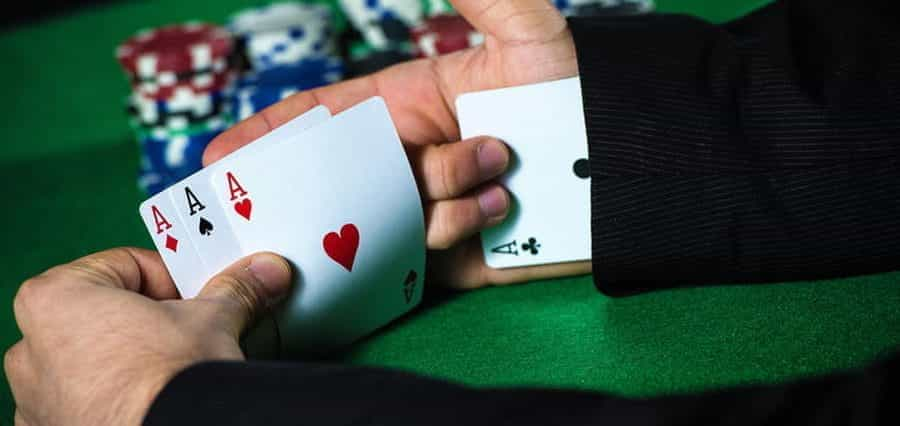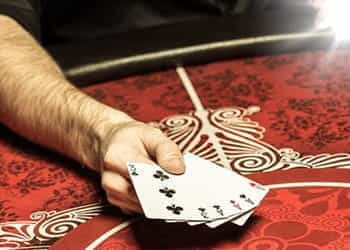
1. Phil Ivey – Baccarat Snake
 The notion that a ten-time World Series Poker bracelet holder could be involved in a cheating scandal is enough to rock the poker world, and back in 2012, it did. Phil Ivey found himself embroiled in two lawsuits with international casinos over millions of dollars that both casinos claim he won using nefarious methods. These methods were described as ‘edge sorting’, and as the story unfolded, it appeared that Ivey was a master at it.
The notion that a ten-time World Series Poker bracelet holder could be involved in a cheating scandal is enough to rock the poker world, and back in 2012, it did. Phil Ivey found himself embroiled in two lawsuits with international casinos over millions of dollars that both casinos claim he won using nefarious methods. These methods were described as ‘edge sorting’, and as the story unfolded, it appeared that Ivey was a master at it.
Edge sorting involves taking careful note of the cards that are being played and identifying defects in the prints on the back of them. As a VIP gambler at both the Borgata Casino in Atlanta and Crockford’s in London, Ivey had the sway to demand that his games were played with the same set of cards, giving him enough time to learn the decks and sort which cards were winners and which cards were losers. By employing edge sorting tactics whilst playing baccarat, Ivey won $9.6 million and £7.8 million pounds at the Borgata and Crockford’s respectively.
Edge sorting wasn’t exactly the most well-known method of cheating – even Ivey had to be taught it by another gambler Cheung Yin Sin. It was that unknown at the time, in fact, that the Borgata even allowed Ivey to take home his winnings despite their suspicions. It was when Crockford’s refused to pay him his winnings when the dispute heated up to a court case. When Ivey counter-sued, he claimed that he had earned his winnings fairly as edge sorting was a skillful tactic rather than a cheat. The case dragged on for years until the courts decided against Ivey’s claim and now edge sorting is considered not only dishonest but an official cheat.
2. The Inside Job
 Sometimes, cheaters will come up with an idea so great that they won’t be able to resist trying it over and over again, leading to their downfall. Such was the situation in France in 1973 when staff at the Casino Deauville were baffled by a gambler’s week-long 5-million-franc winning streak. Being a game of pure luck, they couldn’t get their heads around how anyone could strategize or be lucky enough to take home what is the equivalent to $1 million USD today so quickly.
Sometimes, cheaters will come up with an idea so great that they won’t be able to resist trying it over and over again, leading to their downfall. Such was the situation in France in 1973 when staff at the Casino Deauville were baffled by a gambler’s week-long 5-million-franc winning streak. Being a game of pure luck, they couldn’t get their heads around how anyone could strategize or be lucky enough to take home what is the equivalent to $1 million USD today so quickly.
Security quickly suspected that there must have been an inside job, yet investigations into the croupier revealed nothing. They thought that maybe the roulette table had been manipulated, but again, when they pulled it apart piece by piece, they found no evidence of tampering. Coincidentally, at the time of the lucky gambler’s winning streak, the proprietor of the casino had happened to become smitten with one of the casino’s regular guests, a beautiful brunette that had visited the premises every night of the week.
If it wasn’t for his infatuation, the case may have never been solved, because although she rejected all of his moves, he couldn’t help keeping a close eye on her. It was over the course of a few of these evenings spent watching her that he realized that she always sat nearby the lucky gambler, yet she never seemed to make any bets. On top of this, she always seemed to be holding a packet of cigarettes, yet he never once observed her taking one out and smoking it.
Something clicked and he approached her, asking for a cigarette. She couldn’t have refused if she wanted to – he was backed up by security. It was found that inside the cigarette pack was a hidden radio transmitter that the beautiful woman could use to control the roulette ball with. Not only that, the security team’s first hunch that there was an inside job also proved to be correct, as the roulette croupier was discovered to be in on the cheat. It turned out that whenever the gambler sat down at his table, the croupier would swap out the ball with a manipulated duplicate. By working together, the gambler, the beauty, and the croupier could control the spin of the ball with the radio transmitter and control the table to calculate where it would land to pin-point accuracy.
If it wasn’t for the fact that the casino owner was completely enamored by the conniving beauty, of for the team’s inability to quit while they were ahead, the beauty, the croupier (her brother) and the gambler (her husband) may have just got out of there with their millions in tow.
3. Edward Thorp – The Inventor of Card Counting
 There has probably been no one else who has influenced how casinos operate more in the last century than Edward Thorp, the genius Math Professor who took his knowledge of physics, mathematics, and probability to develop a method that anyone could learn to take on the house and win. Many have heard about card counting but few really know how to do it well. It is essentially a method that can allow blackjack players to learn the cards that are being played on their table and use the knowledge to give them an upper hand over the house.
There has probably been no one else who has influenced how casinos operate more in the last century than Edward Thorp, the genius Math Professor who took his knowledge of physics, mathematics, and probability to develop a method that anyone could learn to take on the house and win. Many have heard about card counting but few really know how to do it well. It is essentially a method that can allow blackjack players to learn the cards that are being played on their table and use the knowledge to give them an upper hand over the house.
Edward Thorp first began to craft the method after he was taken to Las Vegas on a holiday. Never really being one for gambling and casinos in his studying days, he began to take an interest in the probability of gambling, and in particular, blackjack. He saw the potential for beating it with maths, and after spending years researching the game, he soon discovered a system that would inform you when to raise your stakes in blackjack. It wasn’t until he started bringing his methods to the casinos that they began to notice that they were in for a challenge.
No matter how closely they watched, they couldn’t quite figure out how Thorp was winning so much. He took home thousands every weekend right from under their noses yet there were no identifiable factors that could help with an accusation of cheating – because when it came down to it, the method was so obscure that it couldn’t be said Thorp was cheating at all. It wasn’t until 1962 when Edward Thorp would publish his debut guide Beat The Dealer when casinos would truly know what he was up to. The book would go on to inspire generations of amateur and professional gamblers alike, and to this day professional dealers are trained to keep a close eye on card counters.
Thorp continued to make money from wise bets and has since gone on to be a legend of Wall Street banking and perhaps one of the wealthiest gamblers in the world. Thorp’s methods would go on to inspire the legendary MIT Blackjack Team, whose card-counting antics would be later immortalized in the heist film 21. Whoever said learning math would never pay off clearly never knew it could be applied in gambling.
The thing to say is that counting cards is not actually against the rules of blackjack. It is, however, against the interests of casinos, which are well within their rights to ban a player for using it to increase their profits. If – with this in mind – reading this makes you hungry to try it for yourself, you can find out how to card count if you check out our blackjack rules guide and accompanying instructions on how to count cards.
4. The Camera in the Cards
 Phil Ivey wasn’t the only one to terrorize baccarat tables with his sly talent and gutsiness. The Cutter Gang as they would later be dubbed by the media were a group of Asian tech-savvy scammers that would terrorize baccarat tables around the world. What attracted the gang to baccarat, in particular, was the fact that it allowed one of the players the opportunity to cut the deck before they started playing. For many, this is seen as a gesture of goodwill, but for those accustomed to the criminal world of trickery, this proved to be a chance at taking on the house – and it paid off.
Phil Ivey wasn’t the only one to terrorize baccarat tables with his sly talent and gutsiness. The Cutter Gang as they would later be dubbed by the media were a group of Asian tech-savvy scammers that would terrorize baccarat tables around the world. What attracted the gang to baccarat, in particular, was the fact that it allowed one of the players the opportunity to cut the deck before they started playing. For many, this is seen as a gesture of goodwill, but for those accustomed to the criminal world of trickery, this proved to be a chance at taking on the house – and it paid off.
Hidden inside the chosen cutter of the gang’s sleeve was a tiny spy camera. As they would cut the deck, the camera would take photos of the cards in the deck. Once the deck had been returned and enough time would pass, the cutter would excuse themselves from the table to assess the images before reporting it back in secret to their co-conspirators. Armed with the priceless information, the Cutter Gang would go on to fleece Vegas casinos for over $1 million. They disappeared as investigators began to form a profile on them and of their tactics. When they were to emerge sometime later to test their luck in New Zealand’s SkyCity Casino, authorities would be waiting for them. Noticing that they fit the description as shared by international investigators, security waited for the cutter to rise after cutting the deck and when that happened, they put an end to the Cutter Gang’s schemes once and for all.
5. Tommy Glenn Carmichael – Slot Hacker Extraordinaire
 There is probably no larger threat to the survival of the online casino industry than a highly-coordinated cyber attack. Hacking could have the potential to not only target the websites but the users, and it is understood that online betting sites will pay top-dollar to guarantee the security of their own and their customers money. But in the 1980s, hacking was much more than a denial of service attack and malicious coding. It required technical know-how and a certain set of tools – both of which the infamous slot hacker Tommy Glenn Carmichael had under his belt. Once a TV repairman, Tommy first played around with the idea of hacking machines when a friend showed him the insides of a slot machine. It didn’t take him long to develop the Monkey Paw, a special tool made from a guitar string and a steel spring that would allow him to manipulate slot machines into thinking he had hit the jackpot.
There is probably no larger threat to the survival of the online casino industry than a highly-coordinated cyber attack. Hacking could have the potential to not only target the websites but the users, and it is understood that online betting sites will pay top-dollar to guarantee the security of their own and their customers money. But in the 1980s, hacking was much more than a denial of service attack and malicious coding. It required technical know-how and a certain set of tools – both of which the infamous slot hacker Tommy Glenn Carmichael had under his belt. Once a TV repairman, Tommy first played around with the idea of hacking machines when a friend showed him the insides of a slot machine. It didn’t take him long to develop the Monkey Paw, a special tool made from a guitar string and a steel spring that would allow him to manipulate slot machines into thinking he had hit the jackpot.
In time, the over-confident Tommy was caught and put in jail, and by the time he was released, the manufacturers of the machines were savvy to tricks like the ones he employed and had updated the security of their machines. Tommy wouldn’t be deterred. Over the next ten years, Tommy continued to develop tools that he would use to break into casino slots. This included the Light Wand, a device that would use a ray of light to trigger the new machines’ sensors and force them to pay out jackpot winnings. Tommy didn’t slow down from there. He went as far as to pose as a potential buyer of slot machines so he would hear the sales pitch from manufacturers that included all the nitty-gritty details about their security systems.
At the height of his scamming days, Tommy not only sold his inventions to other scammers but operated a crew of machine hackers that would take Las Vegas and Atlanta for all they could. One day of hacking alone saw them steal roughly $5 million, but their luck would be short-lived. They were caught and incarcerated in 1996. Since being released from prison, Tommy has given up his ways as a slot machine thief, making amends with his former casino foes to the point that he finds employment as a casino security consultant. His rehabilitation had gone so far that he has claimed that he is working on a defensive mechanism so unbeatable that it will stop slot hacking for good.
But it wasn’t enough. Nevada Deputy Attorney General Jennifer Carvalho said that although his Protector could be used as a protective device, it could readily be converted to a powerful hacking device and he has since been banned from stepping in any Nevada casino for life.
6. Keith Taft – The Computer Wiz
 It seems obvious today why casinos would ban the use of computers to help gamble in the modern age, but decades ago, the computer was seen as a threat small enough to ignore. It was this blind-spot plus the groundbreaking work of our previously covered mathematician Edward Thorp that inspired Sunday-school teacher Keith Taft to use technology and maths in his quest to win big at blackjack.
It seems obvious today why casinos would ban the use of computers to help gamble in the modern age, but decades ago, the computer was seen as a threat small enough to ignore. It was this blind-spot plus the groundbreaking work of our previously covered mathematician Edward Thorp that inspired Sunday-school teacher Keith Taft to use technology and maths in his quest to win big at blackjack.
Now, when it came down to it, Keith Taft was in no way especially talented at neither card counting nor gambling, but what he did possess was a knack for computer sciences and a keen sense of perseverance. He decided to construct a 15-pound self-made computer to help him keep track of cards, which he would then disassemble and piece together in different compartments that would be hidden across his body. How did he control it without being seen? The controls were hidden in the soles of his shoes, of course, and he would type in the data that he would notice in blackjack by tapping on his toes.
Ingenious? Not quite yet. It took three years of failure with his primitive computer system for him to realize that the machine simply wouldn’t be efficient yet to collect, analyze and report the data back to him quick enough to play. So he built a new machine, a lighter device that would prove to be a whole lot more quick and accurate than his previous device. The new machine would guide Taft to some impressive wins, but after a short while, he would be discovered by the FBI and his device would be seized. In today’s world, he would be thrown in jail with a whole slew of charges against his name, but not understanding the device or how he used it, the FBI released him to a regular life of respectable civilian activity.
Just kidding – he enlisted his children to pull off a more intricate scheme. For years, Keith and his children would attack the blackjack tables with a variety of devices that could calculate the positioning of certain cards in the deck, could use cameras to spy on cards and other communication devices that could allow him and his team to communicate their findings through wires in their shoes. As the years went on and dealers, casinos and the law began to take action on their tech-savvy scammers, Taft would give up his cheating ways and rest on his hard-earned winnings.
7. Richard Marcus – The Sneaky Drunk
 You may have noticed that for the most part, many of our cocky casino cheaters have usually had their careers cut short by the flawless security teams of the House paying close attention to their somehow impossibly lucky victories. There are perhaps many out there that have got away with their scams whose names elude us. The braggadocious Richard Marcus is not one of them. His scam was somewhat simple.
You may have noticed that for the most part, many of our cocky casino cheaters have usually had their careers cut short by the flawless security teams of the House paying close attention to their somehow impossibly lucky victories. There are perhaps many out there that have got away with their scams whose names elude us. The braggadocious Richard Marcus is not one of them. His scam was somewhat simple.
Apparently belligerently drunk, he would walk over to a roulette table and throw down $15. Much to his surprise, he would a $1,000 prize, and in his drunken celebration, dance like a lunatic. Annoying? Yes, but not totally unexpected for a man as wasted as he seemed to be. Now, what looked to be sheer, dumb luck was, in fact, a scam that initially would leave anyone who understood the odds of roulette scratching their heads. But unlike many of the other cheats on this list who use technology, mathematics, and teamwork to take down the house, Marcus owed more of his inspiration behind his signature “Savannah” move to magicians as opposed to creative genius.
By employing sleight-of-hand, Richard would stumble over to bet three red $5 chips on the table, being sure to hide a $500 brown chip below them and hidden out of sight from the croupier. If Richard was successful, he would come out with $1,000, but if not, he would use his fake drunkenness to distract the table enough to retrieve his $500 chip. Over the years, Marcus claimed that he had earned over $5 million in the process.
What set Marcus apart from the rest of the gamblers was that he never cheated while winning – his tactics relied on cheating when he lost. This meant that there were no reasons to inspire casino security to closely watch him all the time. Of course, he was to be caught and charged eventually. Seeing the light, he would later quit his “Savannah” act and go on to run seminars on casino security as well as giving away secrets in memorable TV appearances. You know what they say; if you can’t beat them, join them.


